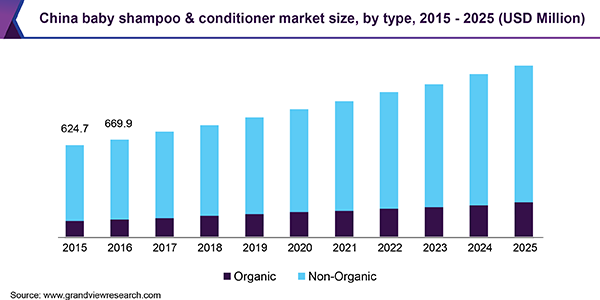The global baby shampoo and conditioner market size is expected to reach USD 6.8 billion by 2025, according to a new report by Grand View Research, Inc., expanding at a CAGR of 5.1% over the forecast period. The market growth is attributed to rising birth rate, growing expenditure on baby care products, increasing purchasing power, and rapid urbanization. Moreover, the need to remove flakes, prevent scalp infection, and combat tangle and knots in baby’s hair is a key factor driving the market.
Increasing literacy rate and growing working women ratio are increasing the awareness among the consumers to differentiate the usage of products for baby grooming. Moreover, due to rising concerns among parents over baby’s health and hygiene, manufactures are focusing on fulfilling the need and demand of the consumers.
Working women are the prime customers for the purchase of shampoos and conditioners. Softness, suitability, anti-bacterial properties, and pleasing fragrance are the factors on which manufacturers are focusing to add more value and credibility to the product. This, in turn, influences the purchasing and spending decision of the consumers.
For instance, Johnson’s Head-to-Toe baby wash and shampoo is the most popular among consumers and is currently at no.1 position in hospitals in U.S. Moreover, the brand claims that it is paraben-free, phthalate-free, no more tears formula, and is as gentle as water on the baby’s eyes.
However, presence of harmful chemicals such as phthalates and formaldehyde in shampoos is acting as a restraint to the growth of the market. Innovation, regulation standards, and marketing are the challenging issues for manufacturers while launching products in the market. Affordability, easy availability, and low awareness about presence of harmful chemicals for the baby’s skin among consumers in rural areas are boosting the growth of non-organic segment.
Consumers prefer to use an organic shampoo for their kids, making sure that babies are not exposed to any kind of dangerous chemicals. This factor is positively influencing the growth of organic shampoo and conditioners. However, manufacturers are highlighting factors such as ‘gentle bath’.
Most product endorsements focus on the softness of baby skin and its incompatibility with the products used on grownups. Thus, mild shampoos have become one of the sought after products and brands including Himalaya, Natural, and Mee Mee have used it to propose some of their products. These promise to keep the baby’s hair moisturized for better and healthy growth. The inclusion of specific herbs has also been appreciated by the brands. Chamomile is one such herb that is included in baby shampoo, Cetaphil. The product is expected to bring soothing effects of Cetaphil.
Asia Pacific held the largest share of above 50.0% in 2018. It is anticipated to emerge as the fastest-growing market over the forecast period. This substantial growth and enormous share can be attributed to the birth rate in countries including China and India. According to a report by China’s National Statistical Bureau, in 2016, 17.86 million infants were born, followed by 17.23 births in the year 2017. Similarly, according to the UN report released in July 2019, India’s current population is 1.37 billion and by 2050, it is expected to grow by 273 million. The data showcases a consequential birth rate.

To request a sample copy or view summary of this report, click the link below:
Further key findings from the report suggest:
- By type, the organic segment is expected to witness the fastest growth in the forecast period owing to its health benefits and vitamin boosted products
- The Asia Pacific held the largest market share in 2018. It is expected to witness the fastest growth over the forecast period due to growing disposable income in developing economies such as China and India, along with increasing birth rate
- Some of the key players operating in the global baby shampoo and conditioner market johnson & Johnson, The Himalaya Drug Company, Unilever, Burt’s Bees, Beiersdorf, and L’Oreal.